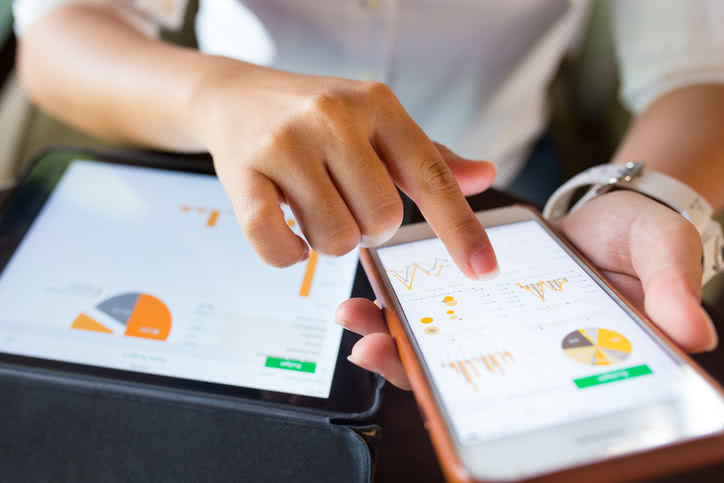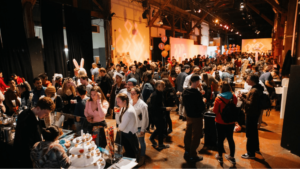Experts in event marketing use big data to unlock insights and create effective strategies to promote their events.
With vast amounts of data and sophisticated analytics tools at their fingertips, event creators can perform nuanced analyses with years of data and elevate their events to new levels of success.
It may sound somewhat daunting if you’re a “non-techie” event creator or if you work on smaller scale events, but we will show you how anyone can take advantage of this huge technological advancement, with the right tools.
Eventbrite collects data from the thousands of events on our platform, allowing creators to leverage this data and data from events at large. In this post, we will demonstrate how event experts utilize big data analysis to gain insights and show you how you can do the same.
What is big data and how does it apply to event marketing?
Big data refers to large and complex data sets generated from different sources such as social media, mobile devices, and digital platforms.
So what’s the difference between normal “vanilla” data and big data?
Unlike traditional data analysis methods, big data requires specialized tools and technologies to process and extract meaningful patterns, trends, and insights.
With the help of advanced analytics tools and technologies, this data can be analyzed to uncover hidden patterns, trends, and insights that would have otherwise not been noticeable and can help you to advance your business.
24% of companies already use big data, so it’s no wonder the events industry has embraced this technology. In event marketing, experts use big data to better understand their customer’s behavior, preferences, and interests.
Event creators use this information to guide decision-making and create personalized, targeted campaigns that resonate with their audience.
For example, an event marketer might analyze data from past events to identify the most successful marketing channels, the demographics of attendees, and their feedback.
Eventbrite did that just last year. Using data collected through our platform, we produced this insightful Summer Trends Report to allow event creators to make informed decisions for their summer events. For example, we found that 46% of those surveyed are expecting to attend more events or live experiences in summer 2023 compared to summer 2022. So planning a summer event this year is likely a good call.
Another way to use big data is to use real-time data from social media to track conversations, monitor sentiment, and tweak your ad campaigns in real time.
Big data also helps event marketers to optimize their events, from ticket sales to post-event analysis. You can optimize ticket pricing and availability by analyzing ticketing platform data to maximize revenue. Data from event apps and survey responses can be used to understand the attendee experience and identify areas of improvement.
Let’s dive deeper into how to do all this.

4 ways the experts are using big data in event marketing
Big data might seem inaccessible, but expert event organizers already use it to market their events. Here are four of the top ways they’re using big data analytics to improve their event marketing.
1. Modeling future event attendance
By leveraging historical data from past events and real-time data from social media, event organizers gain valuable insights into attendee behavior, preferences, and interests.
You can use these insights to create predictive models that estimate future attendance and inform budgeting and sponsorships. Big data analytics can work exceptionally well when combined with your Eventbrite event data analytics. Eventbrite’s analytics tool helps you make informed decisions for future events by giving you the power to harness all of your data through greater visibility and usability.
Modeling future event attendance
Future event attendance models informed by big data help you know more about attendees’ behavior and preferences.
With insights from trends in events, food, and more, you can more accurately predict how many attendees you’ll have and what they’ll be interested in. For example, most Americans claim they’ll attend more events in 2023 than in 2022. That kind of information can inform how you forecast your own event attendance.
Big data lets you analyze how social media trends, current events, and other factors influence interest in events like yours. That way, you can create more precise attendance predictions. You can also improve your budgeting and sponsorship efforts by modeling future event attendance.
That means you can budget more accurately for food, drinks, supplies, staffing, and other variable attendance costs.
Predicting event demographics
Big data can also give you more clues about who might attend your event. By analyzing data from past events and looking at trends, you can identify patterns in ticket sales and attendee demographics.
You can use this information to create targeted campaigns that appeal to a specific demographic, increasing the effectiveness of your campaigns and raising attendance rates. You may already do this with your limited datasets, but aggregating your past event data with data from other sources like social media can make it much more accurate.
Gaining sponsorship for your events
Event sponsors always want to know how many people will attend your event, so attendee numbers informed by big data are a no-brainer for events interested in acquiring more sponsors.
If your event has experienced annual growth, it serves as a compelling indicator of your value as a partner. Demonstrating an increasing number of attendees showcases your event’s appeal and makes a strong case for potential partnerships.
The more certainty you can provide about your attendee numbers, the better. To win event sponsors with your data, accuracy, and volume of data are both key.
To summarize, expert event organizers use big data to predict attendee numbers. This enables them to:
- Build accurately targeted marketing campaigns based on demographics and trends
- Better budget their events
- Improve chances of gaining sponsors based on accurate predictions of attendee numbers
This kind of value is what’s leading 93% of organizations to increase their data investments in 2023.

2. Understanding the impact of marketing efforts on events
With big data analytics, event organizers can quickly identify which marketing channels are most effective, which messaging resonates best with their target audience, and what needs to be adjusted to optimize an event’s marketing performance.
Identifying the most effective marketing channels
Real-time data insights from social media also help determine which social media channels are most effective in driving attendees to your events. By tracking views, comments, likes, and other types of engagement, organizers can discern which channels generate the most response — and focus their efforts on the most effective communication routes.
You can even find out which social media platforms are growing or shrinking in popularity, so you can make more accurate predictions about where to spend your social media advertising budget for future events.
Tweaking the message
By analyzing data from social media, you can track the performance of your marketing copy and quickly adjust your messaging to better appeal to your target audience. Big data analytics inform those decisions, and tools like Eventbrite Boost let you execute data-informed choices on the fly.
The result is an agile marketing campaign continuously personalized to your audience’s interests.
Social media sentiment analysis
Marketers can leverage big data analytics to analyze social media conversations and the sentiment surrounding their events. By monitoring social media platforms, sentiment analysis tools can extract insights from the vast amount of user-generated content.
This analysis helps marketers understand attendee opinions, identify potential issues, and gauge overall sentiment to make informed decisions and respond effectively.
Tracking marketing return on investment (ROI)
By analyzing the data from ticketing platforms, you can identify which marketing campaigns generate the most revenue and optimize your marketing spend for maximum ROI.
You can also identify which marketing channels generate the most ticket sales, allowing you to adjust your marketing mix to focus on the most effective channels.
Industry-leading event organizers are already using big data to enhance their marketing campaigns. They use big data to identify the best marketing channels, continuously improve their marketing campaigns, and get a better ROI on their marketing budgets.
By using big data yourself, you can do the same.

3. Targeting event marketing to specific audiences
Big data is invaluable for targeting event promotions and discounts to specific audiences. The social media and past event data you gather aren’t just useful for ad campaigns and attendee models. You can use that information to create targeted promotional campaigns and discounts that appeal to each group’s unique characteristics.
Find which channel your audience segment uses
You can use big data to identify which social media channels specific groups are most active on and what content they engage with the most. You can then tailor content, promotions, and discounts to these groups and communicate them through their preferred channels.
For example, you can make a discount code with Eventbrite and distribute it to people using a specific social media platform.
Tailor your ticket types
You can also make new ticket types to appeal to different audiences. By analyzing data from past events, you can identify which types of tickets are most popular among different demographics, such as early-bird discounts or VIP packages. You can then create ticket packages that cater to these preferences with Eventbrite and offer them to your target audience.
Improve attendance and ROI from promotions and discounts
Using big data can also improve attendance and ROI from promotions and discounts. By tracking the performance of these campaigns in real time, you can adjust your promotional strategies to increase engagement and attendance rates. That goes beyond general marketing analytics, allowing you to attribute specific discounts and deals to their generated revenue.
Event experts ensure that every discount they provide boosts revenue, making sure their deals are targeted and they aren’t losing any money by giving unnecessary discounts.
Using big data, you can do this even more accurately than before.

4. Using attendee insights to improve future events
Using attendee insights at events can provide valuable feedback to event organizers and help them improve future events.
Big data can help event organizers gain insights into the attendee experience by analyzing data from surveys, event apps, Radio-Frequency Identification (RFID) technology, and social media. By analyzing this data, event organizers can identify areas for improvement and make data-informed decisions to optimize future events.
Identifying attendee preferences from past events
Analyzing attendee insights from past events allows you to identify trends and preferences to inform future event planning. Paying attention to preferences makes Netflix $1 billion a year in customer retention, and it could have a similar (if a little smaller) impact on your events.
For example, by analyzing post-event survey responses, event app data, and social media conversations, you can identify specific pain points that need to be addressed in future events and what aspects of the event attendees enjoyed the most. This can inform decisions on which activities or speakers to repeat at future events and which ones to avoid.
At Eventbrite we have access to thousands of event creators and their attendees. Each year we use a survey to check in with our event creators to see how they’re faring.
At the end of 2022, we also surveyed 4,474 event attendees asking them if their enthusiasm for events would change in the new year, what they wanted to see more of, whether inflation was tightening their purse strings and much more. We compiled all this data for you in our 2023 Event Trends Report.
Data like this allows event creators like you to make predictions and streamline your efforts on what will matter most.
Using RFID technology
You can also use RFID tracking to analyze attendees’ behavior during the event, including which sessions or activities were most popular, which had the highest engagement rate, and which had the highest drop-off rate.
RFID chips on objects like wristbands or event badges encourage people to scan into specific event sections, like booths, activities, stages, or rooms.
As you can imagine, that generates a high volume of data — hence the name big data — but it can be invaluable for event organizers. With RFID data, you can optimize future events by scheduling sessions at more optimal times, improving the event flow, and avoiding scheduling conflicts.
Organizers at SnowGlobe Music Festival used Eventbrite’s RFID solution for a wide range of benefits, including faster and more secure entry. But that same RFID data could let the festival organizers know when people entered and exited the festival, as well as any particular areas they entered. Organizers could use that information to make smarter decisions later on.
How Eventbrite enables event marketing with big data
Eventbrite lets you use more advanced analytics in your own event marketing efforts.
With Eventbrite’s marketing tools, you can change your marketing campaigns live to improve their performance.
That gives you the agility to respond quickly to changing preferences and trends. Once you have insights from your big data analytics, Eventbrite helps you implement them.
On top of that, Eventbrite’s ticketing solution lets you create ticket types and discounts that target different audience segments. That means you can use the insights from big data analysis to create tailored promotion campaigns that appeal to those segments, improving your overall attendance as well as the ROI of those campaigns.
Finally, Eventbrite’s invitation and RSVP tool lets you collect data from attendees through voluntary surveys. Analyzing that data on top of big data from social media and other sources enables you to make more informed decisions about audience patterns and preferences.






